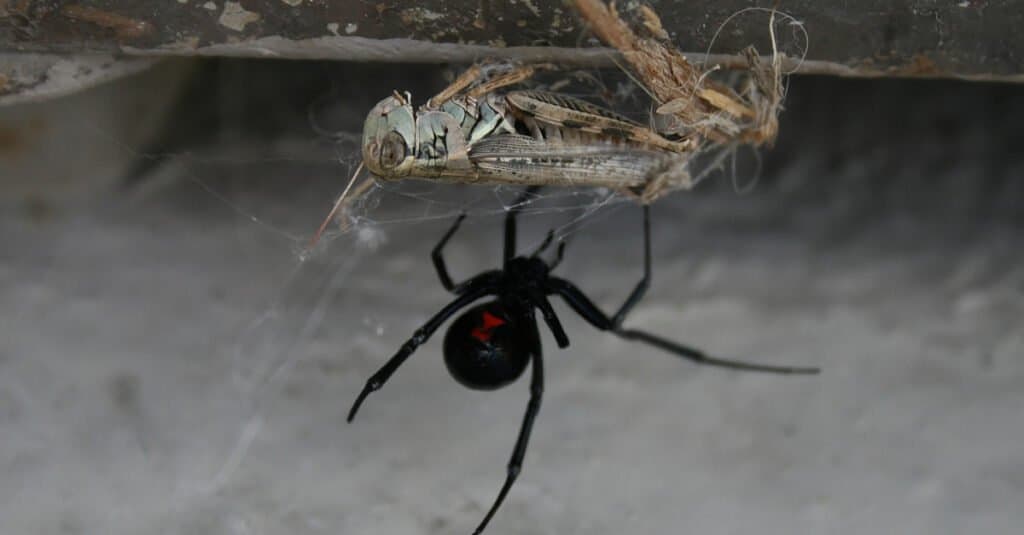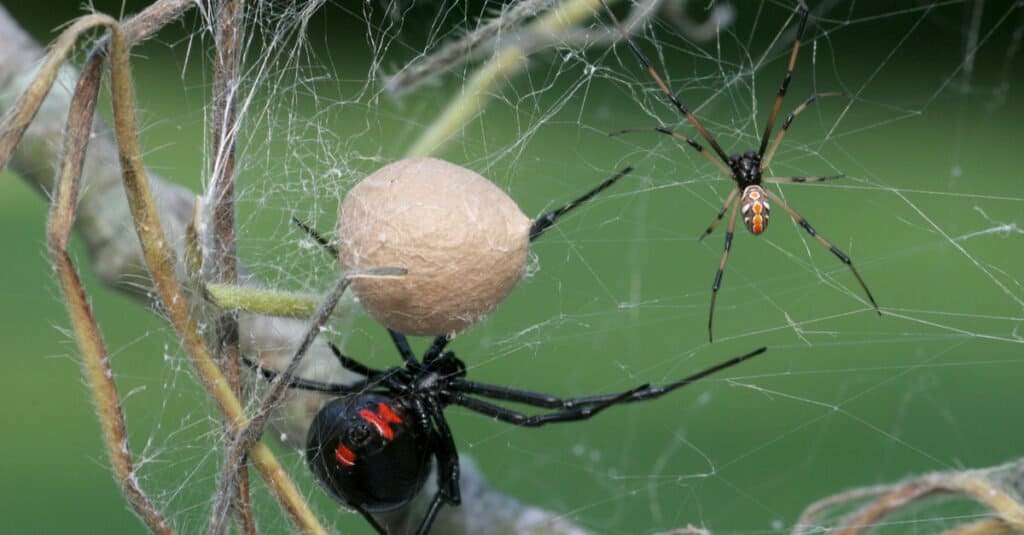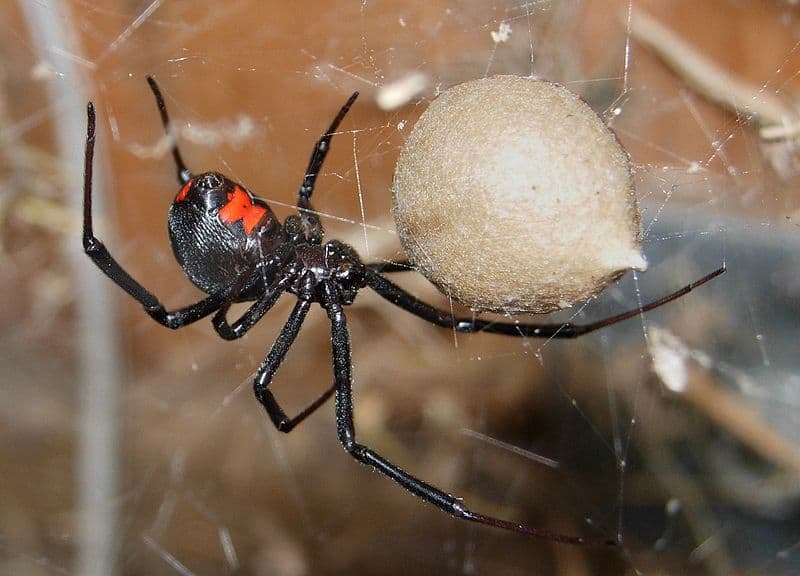Black widows are well known for their dark bodies and red hour glass markings. They can be found in temperate areas all over the world, and are particularly prevalent in the southern and western United States. Male black widows are smaller, and less recognizable than females, though they are just as venomous.
Here, we’ll learn more about what black widows eat, how they hunt, and whether or not they really eat their mates. Then, we’ll explore just how dangerous black widow bites are, and what to do if you’re bitten. Finally, we’ll look at what baby black widows eat.
The Black Widow Diet

Black widows are carnivorous and eat flies,
caterpillars
, ants, and other insects
©Crystal Kirk/Shutterstock.com
Black widow is the name commonly given to any one of the 31 species in the Latrodectus genus of spider. All species of black widow eat the same things, namely, insects.
Black widows eat a variety of flying and climbing bugs including flies, grasshoppers, and other spiders. They are carnivores.
The black widow’s favorite foods are:
- Flies
- Ants
- Grasshoppers
- Cockroaches
- Spiders
- Beetles
- Caterpillars
- Mosquitos
Black widows are opportunistic eaters, and will devour just about anything that gets stuck in their web. For some black widows, this even includes small snakes, lizards, and scorpions.
How Do Black Widows Hunt?
Black widows are reclusive spiders, and prefer to sit and wait for their prey to come to them. To achieve this, they spin irregular webs in out of the way places like wood or debris piles, vents, or unused doorways. Then, they wait, hanging upside down, for an insect to become entangled in the web.
Black widow spiders have poor eyesight, and can’t jump. But, when something like a fly lands on their web, they can detect the vibrations in the silk, and quickly move towards the struggling prey. With one quick bite, they deliver a dose of paralyzing alpha-latrotoxin.
Next, the black widow spins silk around the insect using special comblike hairs on their back feet. Once the prey is all wrapped up, the black widow sprays digestive juice over it. The digestive juices liquify the prey, and the black widow then sucks up the already digested remains.
Do Black Widows Really Eat Their Mates?

Black widows engage in cannibalism, with females sometimes eating males after mating.
©Mark_Kostich/Shutterstock.com
Female black widow spiders are famously known for eating their mates directly after mating, but how much truth is there to this cannibalistic act?
As it turns out, female black widow spiders will in fact eat the male of the species, but not always. Well fed black widow females rarely eat males after mating, but the same cannot be said for hungry females.
Female black widow spiders are much larger than male black widows, which make easy prey for the hungry female. It is possible that hungry female black widows consume the male directly after mating to increase the chances of delivering a healthy brood of spiderlings.
Black widows eat anything that lands in their web, and they are not opposed to eating other black widows—including their mates, if the opportunity arises.1
Are Black Widows Dangerous?
Black widow spiders are the most venomous spider in North America. However, black widows are fearful and reclusive, and would rather stay unnoticed and hidden from human view. They are not aggressive, and will only bite a human or pet in the direst of circumstances. Further, black widows prefer the outdoors, and rarely come inside, keeping them (for the most part) out of the way of humans.
That being said, black widow bites are not uncommon, particularly when people are working or playing outside in the black widow’s natural habitat. They especially like wood piles and out of the way places.
Black widow bites are only life threatening to very young, very old, and health compromised individuals. If you suspect that you’ve been bitten by a black widow, you should seek immediate medical attention.
Black widow bites usually feel like a small pinprick, and can present as either one or two tiny holes. Black widows release a neurotoxin when they bite, which means that their venom effects the nerves. Swelling, pain, fever, muscle cramps, and nausea are common side effects of the neurotoxin. Side effects typically last 8-12 hours, but may linger for days.
If bitten, it is important to seek medical attention and black widow antivenom as soon as possible.
What Do Baby Black Widows Eat?

Black widow spiderlings engage in sibling cannibalism after hatching
©Chuck Evans(mcevan)”./ CC BY 2.5, via Wikimedia Commons – License
Female black widow spiders produce eggs, which they lay in an egg sac. Spiderlings hatch after about thirty days. New spiderlings often wait at the egg sac and eat other, younger spiderlings as they hatch. This is yet another example of cannibalism among black widow spiders.
Black widow spiderlings are usually very light brown and can look almost translucent. Once they leave the egg sac and the mother’s web, they will remain solitary for most of their lives, only coming together to mate and produce spiderlings of their own.
As they grow, they learn to build their own webs, and avoid creatures that eat them, like birds, wasps, and small mammals. If they are male, they have to be careful to avoid hungry female black widows too.
Humans, who often kill spiders if they find them, may be the black widow’s biggest threat. Killing black widows is not always necessary, and they should only be exterminated if they pose a threat to small children or pets, or build their webs in frequently used areas. Many people prefer to let their black widows be, as they provide a natural form of pest control.
The photo featured at the top of this post is © Sari ONeal/Shutterstock.com
Thank you for reading! Have some feedback for us? Contact the AZ Animals editorial team.






